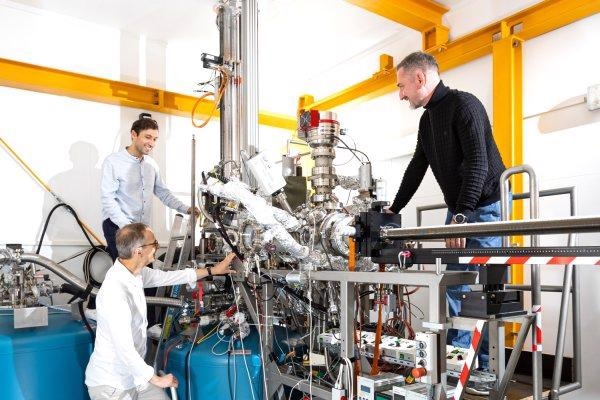Reviewed by Alex SmithSep 1 2021
Scanning tunneling microscopes are capable of capturing images of materials with atomic precision and can be applied to control individual atoms or molecules.
 Professor Stefan Tautz (left below), Dr Taner Esat (left above), and Professor Ruslan Temirov (right) at the Jülich quantum microscope. Image Credit: Forschungszentrum Jülich / Sascha Kreklau.
Professor Stefan Tautz (left below), Dr Taner Esat (left above), and Professor Ruslan Temirov (right) at the Jülich quantum microscope. Image Credit: Forschungszentrum Jülich / Sascha Kreklau.
These instruments have been used by researchers for several years to explore the details of nanoscopic phenomena. A new technique developed by physicists at Forschungszentrum Jülich is currently revealing the potential of the device to understand quantum effects.
Credits go to magnetic cooling as their scanning tunneling microscope operates without any dynamic parts and is almost vibration-free. It also operates at an extremely low temperature of 30 millikelvin. The instrument can allow researchers to unravel the significant characteristics of quantum materials, which are considered to be vital for the development of quantum sensors and computers.
Physicists regard the temperature level near absolute zero to be a certainly interesting area for research, where thermal fluctuations are lowered to a minimum level. The laws of quantum physics become involved and disclose the unique properties of materials.
Furthermore, the electric current flows freely with no resistance. Another instance is a phenomenon known as superfluidity, where individual atoms merge into a collective state and move across each other without friction.
Such extremely low temperatures are also needed to study and exploit quantum effects for quantum computing. Researchers across the globe and from Forschungszentrum Jülich are now dedicatedly working toward this objective.
Quantum computers would perform much better than traditional supercomputers for specific tasks. Yet, the development of this technology is still in its initial stage. An important issue is identifying materials and processes that can form complicated architecture with stable quantum bits possible.
I believe a versatile microscope like ours is the tool of choice for this fascinating task, because it enables matter to be visualized and manipulated at the level of individual atoms and molecules in many different ways.
Ruslan Temirov, Forschungszentrum Jülich
Temirov, along with his research team, with years of work, has developed a scanning tunneling microscope with magnetic cooling to perform this task.
“Our new microscope differs from all the others in a similar way to how an electric car differs from a vehicle with a combustion engine,” stated Temirov.
So far, researchers have relied on a kind of liquid fuel, a mixture of two helium isotopes, to ensure the microscope stays at such low temperatures.
During operation, this cooling mixture circulates continuously through thin pipes, which leads to increased background noise.
Ruslan Temirov, Forschungszentrum Jülich
The cooling device equipped in the microscope developed at Forschungszentrum Jülich has been built on the process of adiabatic demagnetization. This principle was used for a while. It was employed in the 1930s to attain a temperature level below 1 K in laboratory conditions for the first time. It has several benefits in the operation of microscopes.
Temirov added, “With this method, we can cool our new microscope just by changing the strength of the electric current passing through an electromagnetic coil. Thus, our microscope has no moving parts and is practically vibration-free.”
The scientists at Forschungszentrum Jülich are the first ever to build a scanning tunneling microscope using this method.
The new cooling technology has several practical advantages. Not only does it improve the imaging quality, but the operation of the whole instrument and the entire setup are simplified.
Stefan Tautz, Institute Director, Forschungszentrum Jülich
Tautz appreciated the modular design and stated that the quantum microscope also remains open to technical developments and can also be upgraded.
“Adiabatic cooling is a real quantum leap for scanning tunneling microscopy. The advantages are so significant that we are now developing a commercial prototype as our next step,” Stefan Tautz concluded.
Quantum technologies are presently the focus of a majority of the research. The interest of many research groups in such an instrument is, therefore, affirmed.
Journal Reference:
Esat, T., et al. (2021) A millikelvin scanning tunneling microscope in ultra-high vacuum with adiabatic demagnetization refrigeration. Review of Scientific Instruments. doi.org/10.1063/5.0050532.